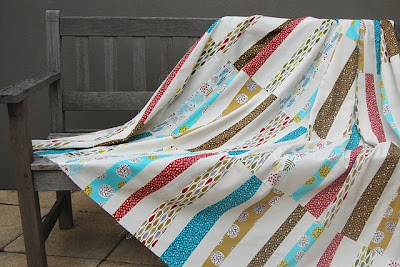W taki oto sposób trafiłam na (dla mnie jeszcze wówczas nieznaną) metodę 'Stack and Slash'. Metoda jest naprawdę banalnie prosta i w bardzo szybki sposób można stworzyć niepowtarzalną narzutę, podkładkę, bieżnik, czy cokolwiek innego.
Poniżej umieszczam zdjęcia podkładek wykonanych w ten właśnie sposób. Uszyłam je z tkanin o intensywnych kolorach. Nie są to "moje" kolory,ale końcowy efekt bardzo mi się podoba. Na końcu tego posta umieszczam fragment bloga Kate, w którym opisuje ona jak uszyć narzutę metodą 'Stack and Slash'. Proszę tylko pamiętać,że tyle ile będziecie miały kolorów tkanin,tyle ostatecznie będziecie miały gotowych bloków. Ja użyłam 9 kawałków tkaniny,każdy w rozmiarze 50cm/35cm i z tego uszyłam 9 podkładek pod talerz, każda w takim samym rozmiarze.
Kolory jakich użyłam,to miodowy, beżowy, 3 odcienie zieleni, 2 odcienie czerwieni i 2 odcienie kremu. Aby uniknąć nadmiernej pstrokacizny,a jednocześnie zachować tę samą żywą kolorystykę wszystkie spody zrobiłam w jednym kolorze-czerwonym.
Całość przepikowałam po szwach.
Poniżej metoda 'Stack and Slash' opisana przez Kate. Cały opis jest w języku angielskim. Jeżeli ktoś będzie miał problem ze zrozumieniem czegokolwiek,to proszę śmiało pytać. Na wszystkie pytania z pewnością odpowiem.
Życzę miłej lektury!!!
Debuko:)
I wanted to share with you a really easy 'Stack and Slash' tutorial. This isn't one of my original designs - I've seen similar quilts around on the Internet, but it is my own method. It uses 8 Fat quarters of patterned fabric and 8 Fat quarters of solid fabric, and it's super easy.
Cut 8 rectangles, 20 1/2" wide x 17 1/2" tall of patterned fabric and another 8 rectangles (20 1/2" x 17 1/2") of a plain solid. Divide them into two piles. Each pile will contain 4 patterned rectangles and 4 solid rectangles. Take one pile and stack the fabric on top of each other, ensuring the edges are carefully aligned. Alternate the plain and patterned fabric, ironing as you go (this will help them stay together as you cut them).
I've used Cloud 9's Nature Walk range and a natural solid.
I've folded back the fabric for instructional purposes only. The fabric should be lying flat.
Using your rotary cutter and ruler, cut through the stack of fabric 7 times, so you have 8 strips. My strips were approximately 2 1/2" wide. Cut on a slight angle - about 1/2 inch difference from top to bottom. You can vary the angle and the width of the strips.
Leave the strip on the far left hand side as it is.
Now go to the strip next to it and move the top fabric to the bottom of its pile leaving a solid strip at the top.
From the third pile of strips, move the top 2 fabrics to the bottom of its pile.
From the fourth pile, move the top 3 fabrics to the bottom. Continue in this manner until all of the fabrics are represented at the top (as shown in the picture).
Sew the top strips together using a 1/4 inch seam. Press seams towards the patterned fabric.
Then sew the next set of top strips together ...
...and so on until you have sewn 8 blocks of 8 strips.
Take your other stack of 8 rectangles that you set aside earlier. Repeat the above instructions to make another 8 blocks, yielding 16 blocks altogether. Trim your blocks so they are all the same size (about 17 1/4" square).
Arrange your blocks by laying them on a flat surface (4 across and 4 down), alternating the first set of blocks with the second (see photo of the quilt). Move and rotate the blocks so that those in the first and third row start with a plain strip and the blocks in the second and fourth row start with a patterned strip. Move the blocks around until you are happy with the colour design and balance. Sew 4 blocks together across the row. Make a total of 4 rows, and then sew these rows together.
Your completed quilt should measure approximately 67" (170cm) square - perfect for a picnic or to throw over the back of the couch.












kolorystyka tez nie moja, ale podoba mi się to zestawienie zieleni z czerwienią na środku! i wzór jest rzeczywiście ciekawy
OdpowiedzUsuńBardzo fajne podkładki i dzięki za linka, lecę podglądać dzieła Kate.
OdpowiedzUsuńPiękne podkładki uszyłaś:) Cudnie sie prezentują:)
OdpowiedzUsuńno no masz już niezłą patchworkową kolekcję na swoim koncie :) gratulacje :)
OdpowiedzUsuńDziękuję serdecznie za miłe komentarze. Jeżeli chodzi o moją patchworkową kolekcję,to wcale nie jest tak pokaźna:( Tak naprawdę dopiero pół roku temu "złapałam" wiatr w żagle. Wówczas zwiększyły się moje możliwości,a przede wszystkim odnalazłam swój patchworkowy styl:):)
OdpowiedzUsuń